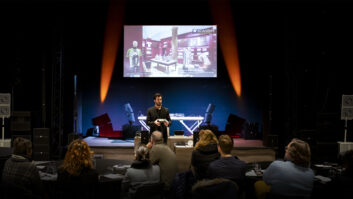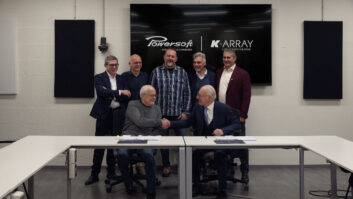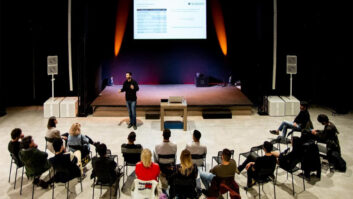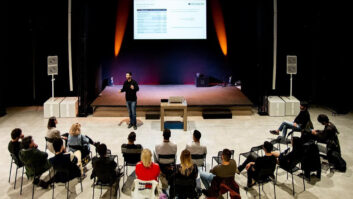
One of the better aspects of my job is the occasional opportunity it affords to visit world-renowned concert halls and listen to music in near isolation. This thought was going through my head as I walked along one of the rows in the circle of London’s Barbican Hall last month, at a Sennheiser UK-organised demo of K-array’s new Firenze loudspeakers. With everyone else in the stalls below, I struggled to resist the temptation to sing along rather than listening to the quality of the sound and the evenness of the coverage.
Francesco Maffei, product specialist at K-array, presented the new system, which consists of just two models: the KH8 mid-high cabinet and the KS8 subwoofer. The self-powered KH8 combines digital beam steering and hardware tilting in the same cabinet. Instead of exhibiting the usual banana shape of line arrays, the KH8 arrays hang vertically; the desired coverage pattern can be obtained by setting the angle of each individual element.
Created with financial assistance from an EU fund aimed at tackling noise spillage, the range was launched in October, but beta testing, in Italy and China, started more than a year ago. The week ater this demo, Maffei was heading for the US to show the system there.
Even coverage
Walking around the Barbican Hall, which seats 855 in the stalls and 767 in the circle, it was striking how even the coverage across the whole of the auditorium from two hangs of six KH8 (plus a KS8 subwoofer). A number of different styles of music were played through the speakers: it handled most styles of music well, reproducing with clarity at high SPL, although an intimate Diana Krall jazz vocal number produced a slightly less satisfactory experience.
Each Firenze KH8 enclosure features eight built-in DSP channels and a total of 20 transducers. Shaping of the wavefront and all beam steering and coverage optimisation is performed electronically by filters calculated by FIRmaker, the sound optimisation tool developed by German pro-audio software company AFMG. Its quoted frequency range is from 60Hz to 18kHz, and maximum SPL is 145dB.
The KS8 sub just tops this, at 148dB. This features IPAL driver and amplifier technology, which allows real-time acoustic correction with just 10us latency.
“We believe Firenze will be interesting for installation in big clubs, but our first target is rental,” said Maffei. The KH8 cabinet is protected to IP45 and the electronics inside to IP65 – and the system has already proved itself capable of withstanding sun, rain and mud at festivals.
Maffei continued: “It’s weatherproof, so thinking about outdoor installations, this is something that can live in the rain, under the sun, for many years. And in clubs, for example, it stays straight, so it’s easier to integrate into the design of the room. And it’s loud! Especially the subs – what we have seen in clubs is that they were really happy with just four subs for a big dancefloor. It’s also smaller than competitors, and can make good coverage with just three panels per side.”
The KH8 speakers are anchored in groups of three within rigid frames, cabled together. These can be connected quickly to create longer clusters; only two cables need to be connected from each frame to the next. This means that, according to K-array, one person can fly a 12-speaker cluster in 10 minutes.
Two types of adjustment
Once the speakers are hung, the coverage pattern can be adjusted physically or by using the software. According to Maffei, errors of up to 5º can be corrected using the software, but for larger adjustments it is better to make a physical adjustment – which is quick to do once you can get your hands on the speaker.
Another time-saving feature is the KH8’s auto-configuration capability: it is possible to design configurations offsite and then sync the system when it is in position and switched on.
The software can automatically calculate the optimum system design for any venue requirement, and suggests the most accurate speaker angle for optimal coverage in the targeted listening area. The optimal FIR settings – to meet any demanding set-up requirement and control sound spillover – can also be calculated at the touch of a button.
Horizontal dispersion is fixed at 120º, but Maffei added that horizontal control is likely to be covered in future developments of the system. The next addition to the range will be the smaller KH7, which is to be presented at Prolight + Sound and will be launched in mid-2015.







